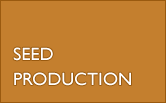Seed production in EU - 2023
"Seed production in EU - 2023" : download the presentation
In 2023, the accepted areas for seed production of major crops[1] within the European Union decreased by 3 3% to 1 986 875 ha. While areas increased for a vast majority of countries noticeable decreases were observed in some countries notably Denmark (-10%) Poland (-10%) Sweden (-8%) and the Netherlands (-12%).
France the leading producer follows the trend with a 3% decline in areas to 349 023 ha while Italy records a 6% growth to 215 164 ha. Spain follows with stable areas (+0 5%) at 192 263 ha, while Germany sees a 7% decrease to 172 434 ha and Poland experiences an 11% regression to 139 289 ha. Hungary which had a 3% decrease in areas in 2022 shows a remarkable increase of 18% in 2023 reaching 124 157 ha.
France remains the world's top producer of major crop seeds retaining leadership in corn, oilseeds, fiber crops, and pulses. Denmark dominates the market for forage grasses, Italy for small-seeded legumes, and beets, and the Netherlands for potato seedlings. Germany remains the leader in legumes ahead of France and the Czech Republic. Spain maintains its lead in cereals ahead of Italy and France.
[1] Excluding vegetables
Straw cereals are clearly at the forefront of the species produced with a total of 956 292 ha. After a 3% decline in 2022, their growth remains limited at 1%. The increase benefits many species except for oats (-10%; 49 515 ha) and spelt (-59%; 4 144 ha). Triticale progresses by 2 5% to 434 402 ha while barley remains stable at 240 310 ha. Spain remains the leader in straw cereals with 125 473 ha (+2%) followed by Italy (120 475 ha; +10%) and France (119 657 ha; -0.3%). France remains the top producer of soft wheat with 66 546 ha (+0.1%) ahead of Romania (50 905 ha; +3.6%) and Germany (44 430 ha; +1%). Spain maintains its lead in the barley market with 44 685 ha ahead of France (30 756 ha; -0.4%) and Germany, which experiences a decline of 4.5% to 30 516 ha.
Since 2021, durum wheat areas have been following a steady growth trend. In 2023, they increased by 4.7% to reach 116 858 ha. This trend is observed in the majority of producing countries, but particularly in Italy, the top producer which totals 69 826 ha (+6.5%), ahead of Spain (19 561 ha; +1.7%), Greece (12 226 ha; +4.2%) and France which records a decrease of 7.5% to 7 228 ha.
In maize cultivation areas decreased by 5% to 172 905 ha. This trend affects the main producing countries including France, the leader for this species which sees its areas decline by 4% to 82 646 ha. Romania and Hungary respectively show a regression of 8.6% to 28 671 ha and 9% to 25 352 ha. However, Poland records a growth of 16% to 5 525 ha.
The total area of oilseeds is 135 864 ha representing a 4.5% increase. Most of the species show remarkable increases primarily driven by soybeans and rapeseed. Soybean cultivation has expanded by 10% reaching a new record of 57 570 ha. Like last year, significant growth is observed in a large majority of producing countries, particularly in Italy, the leader for this species, where areas surge by 31.5% to 15 137 ha, ahead of Croatia (+9.7%; 7 460 ha) and Romania (+4.6%; 7 457 ha).
After declining since 2020, rapeseed areas increase by 7% to 23 225 ha. France, the top producer, records a 6.4% growth to 10 882 ha, while Spain experiences a 3.7% decline to 4 753.5 ha. In Germany, the third-largest producer, areas witnessed a remarkable growth of 20.5% to 3 194 ha following a 25% loss in 2022.
Sunflower cultivation follows the upward trend with a 3% increase to reach 39 464 ha. This growth is driven by France, the EU's leading producer, and Italy, where areas show remarkable growth, increasing by 12.5% to 16 460 ha and by 22% to 3 489 ha respectively. In Spain, areas decrease by 4.3% to 8 934.5 ha, remaining stable in Romania (5 025 ha) and Portugal (2 810 ha). However, they decline by 17% in Hungary (2 094 ha) and by 50% in Bulgaria (523 ha).
In 2023 forage areas continue to follow a downward trend, totaling 476 033 ha, representing a 5% decline. Like last year, the trend is strongly downward for a vast majority of countries, notably Denmark, which remains the leader in this market with 99 062 ha (-12%) Poland (54 430 ha; -14%) France (-13%; 36 807 ha) and Germany (-19.5%; 26 575.5 ha). However, significant increases partly compensate for these regressions, particularly in Italy (+22%; 71 988 ha), Hungary (+32.5%; 3 047 ha), Lithuania (+10%; 18 309.5 ha), and Slovakia (11 107 ha; +15.5%).
The observed decline is mainly driven by grasses with areas dropping by 17% to 216 882 ha. This trend affects all countries except Hungary (+46%; 1 473 ha) and Slovakia (+26%; 2 096 ha). Denmark, the leading producer of these species, totals 92 301 ha (-13%), followed by Poland (22 536 ha; -29%) and Germany (21 461 ha; -20.5%). 50% of the areas are occupied by ryegrass. English ryegrass dominates with 73 169 ha (-20%). Next are fescues (28%), mainly red fescue. There is a notable rebound of 23% in rough oat grass (8 959 ha).
Areas devoted to small-seeded legumes increased by 3% to 147 990 hectares. This trend is observed in most countries, but mainly in Hungary, where the areas have doubled to reach 11 850 hectares. Romania and Greece show respective increases of 50% to 5,148 hectares and 45% to 3,708 hectares. In Italy, the leading producer in the EU, the areas remain stable at 48,566 hectares. France comes second with 22 443 hectares, a decrease of 8%. The observed progression is mainly driven by alfalfa, up by 9%, the most prevalent species in the community space with a total of 76 048 hectares, ahead of crimson clover (23 787 hectares) decreasing by 14%, and crimson clover increasing by 10% to 17 962 hectares.
Large-seeded legumes continue to make significant progress (12%) to reach 35 538 ha, primarily consisting of vetches, which continue to expand (+11%) to reach 34 818 ha. Common vetch, up by 8%, totals 23 983 ha. Spain dominates the market for large-seeded legumes but sees its areas decline by 2.6% to 14 015 ha, ahead of Lithuania and Greece where areas show respective rebounds of 73% to 4 586 ha and 27% to 3 982 ha.
Areas dedicated to cruciferous crops also experienced a significant increase (+11%) to reach 39 483 ha. This trend is driven by mustards (+5%; 25 088 ha), the predominant species among crucifers, and fodder radish (+27%; 13 510 ha). The progression is observed among the main producers, notably in Poland, where the areas show a rebound of 27% to 14 103 ha. The Hungarian and Slovakian areas are increasing by 35% to 5 523 ha and by 25% to 5 495 ha respectively. However, areas in the Czech Republic, the second-largest producer, declined by 3.4% to 7 359.5 ha.
The decrease in potato cultivation intensifies in 2023 totaling 98 007 ha, representing a decline of 7.5%. The Netherlands, the world leader in this crop, covers 37 785 ha (-8.5%). France comes in second with 20 290 ha (-12%), ahead of Germany (16 565 ha; -7.6%), and Poland, where the area decreases by -7.3% to 5 491 ha.
After stability in 2023, areas dedicated to fava beans, lupins, fodder peas, and protein peas increased by 2.5% to 104 382 ha. This trend is observed in a significant majority of countries. Germany, a leader in these species, sees areas stabilize at 16 473 ha. In France, they continue to decline (-4%) to a total of 13 496 ha, ahead of the Czech Republic (9 826 ha; +1.3%) and Spain (9 758 ha; +2%). Peas (forage and protein) increased by 6% to reach 68 865 ha, while fava beans total 26 622 ha, a growth of 4.3%. As for lupins, areas continue to decrease in almost all countries, experiencing a 22% drop to 8 895 ha.
In 2023, beetroot areas continue to decline, losing 11% to a total of 9 434 ha, their lowest level since 2016. Sugar beets decreased by 12% to 8 711 ha, while fodder beets remained relatively stable at 723 ha (-1%). This trend affects many countries, particularly the two leaders in this market France with 4 511 ha (-8.3%), and Italy (4 178 ha; -16.5%).
Areas dedicated to dry vegetables (beans, lentils, chickpeas, and vegetable peas) show remarkable growth of 22% to 9 493 ha. Strong increases are observed in almost all countries except Romania (-9%) and Croatia (-57%). In France, the top-producing country, areas increase by 12% to 4 315 ha, ahead of Spain (1 812 ha; +45%) and Italy (1 208 ha; +27%). All species show increases notably chickpeas (+18%; 4 698 ha) and lentils (+38%; 3 386 ha). Garden peas total 1 224 ha (+2.5%) while bean areas remain limited at 185 ha.
Summary note made by SEMAE (France)







